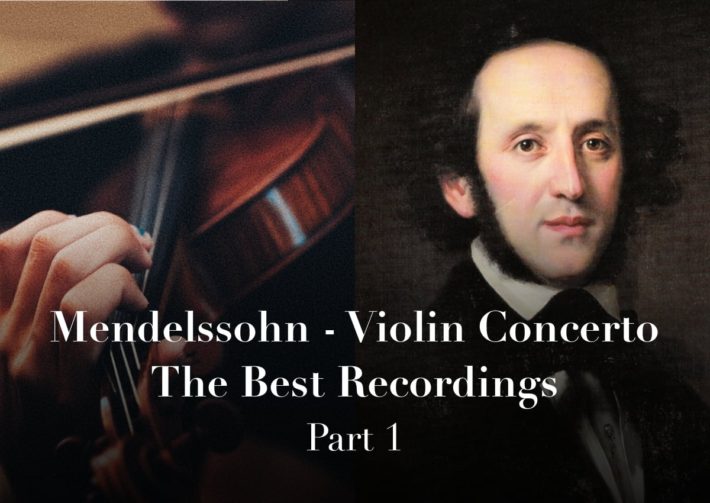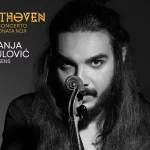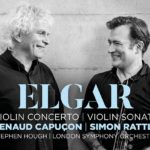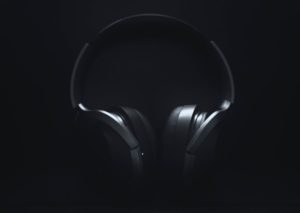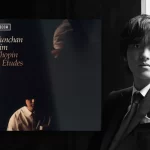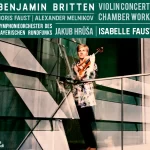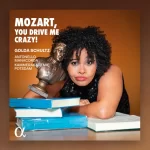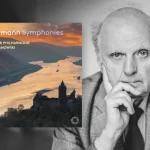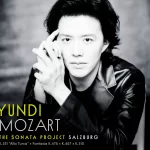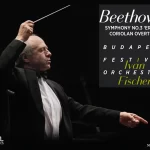Mendelssohn’s Violin Concerto, one of the best pieces by the composer, is also one of the best-known Violin Concertos in the history of classical music. Like many pieces in the same caliber and popularity, the number of recordings is virtually numerous. There seems to be no violinist of stature (and lesser ones) that hasn’t recorded the piece at least once, and in some cases, multiple times. So how do you pick the best recording of the Mendelssohn Violin Concerto?
Like the previous guide published on these pages, choosing the best recordings of Bach’s Goldberg Variations, this guide will go through many recordings, but will settle on three recordings which in this writer’s assessment, best represent the piece. But before we pick the best recording of Mendelssohn’s Violin Concerto, let’s take a closer look at the piece itself.
Mendelssohn Violin Concerto – Composition History
Mendelssohn wrote his Violin Concerto over a period of 6 years, from 1838 to 1844, and it was premiered a year later, in 1845. From the first performances, the Concerto enjoyed extremely positive receptions, and never left the core repertoire.
The vast popularity of the piece does not mean it’s a simple one, not in its compositional inventiveness nor its technical demands. From a compositional standpoint, the Concerto bellies what the audience of the time must have felt was unexpected. Although the first movement is built around the classical sonata form, the violin is ahead of the game, so to speak, introducing the main theme, giving a written cadenza before the return of the main subjects (“recapitulation”) and asks for an extremely demanding technical abilities from the soloist, even in the accompaniment sections. In a “classical” concerto, the orchestra usually gives the introduction of the main themes, and the cadenza comes later, just before the coda of the movement.
Reportedly, Mendelssohn disdained audiences who clap in between multiple-movement pieces, and here he wrote a concerto of 30 minutes that have no breaks in between movements. Although now an almost mandatory piece to have in any violinist’s repertoire, this is far from an easy piece to play, requiring good intonation, vibrato and bow techniques to be adequately performed.
Naturally, Mendelssohn’s Violin Concerto is one of the most recorded works from the classical music repertoire, right from the early days of the recording industry. Violinist Eugène Ysaÿe, for example, recorded a violin and piano reduction of the third movement of the Concerto as early as 1912. When this guide is published (2019), the first known full recording of Mendelssohn’s Violin Concerto was made by the legendary Fritz Kreisler in 1926, and every year there are few more versions released, some successful, some less memorable. In fact, with every evolution of the recording industry, we saw a wave of new recordings released, from the mono to long-play records (LP), stereo, digital, DVD and SACD. The complete recording catalog is in the high hundreds, so choosing the best version is a big challenge.
After going through many recordings, this guide will settle on three versions that can be recommended as the best recordings of the Mendelssohn Violin Concerto. So let’s dive in, starting with some early attempts at putting the Concerto on record.
Mendelssohn Violin Concerto – The Early Days
Most likely, the earliest recording of the Mendelssohn Violin Concerto in full was made in 1926 by Fritz Kreisler, who represented an old Viennese style of music-making. His playing may seem anachronistic to listeners today, yet you can’t deny the utter charm of his humane phrasing, along with his delicate and nonintrusive vibrato. His constant portamento (sliding from one note to another) is more controversial, but is also part of his character and allows a glimpse to practices by some of the late 19th-century violin players. This early recording shows Kreisler in his prime, and although the Berlin State Opera Orchestra is weak in volume, it is nonetheless impressively responsive to Kreisler’s superb control of rubato. As an example, listen to Kreisler’s handling of the second subject of the first movement – how he gently accelerate and then compensates by slowing down, with the orchestra right behind him.
Kreisler’s retake from 1935, taken at the Abby Road Studio with the London Philharmonic under Landon Ronald is better recorded, but missing some of the freshness of the 1926 version. It’s worth making a concession for the audio quality and go for the first recording.
This 1926 version, now on public domain, has many remastering versions. The original EMI/Warner’s remastering attempt is probably the best. The Naxos Historical series, though having made a fantastic job cleaning up unwanted noises from the scratched-up original tapes, also took something away from the tone quality of the violinist. In any case, a must-have version for the Mendelssohn Violin Concerto fans, or for violin fans in general.
On the other spectrum of the old tradition, Joseph Szigeti (1933) presents a classical, almost stoic performance, full of reserved beauty in the second movement and seriousness in the outer ones. In fact, it may be one of the better played second movements from all the performances mentioned in this guide. This is not a perfect performance by all means; the London Philharmonic under Beecham gives a good support but are mediocrely recorded, even for the time, and Szigeti’s bow work is not the best in the first movement, but there is still a lot to enjoy from this performance and violinist, who sometimes stood in the shadow of his more celebrated contemporaries.
Nathan Milstein, another towering violinist, loved the Mendelssohn Violin Concerto and has four official recordings of this piece, not to mention numerous live and broadcasted recordings. Milstein never seized to look for new interpretative and technical approaches and so his recordings of many known pieces remained fresh even after many decades of performing them.
Milstein’s version from the mid-1940s with Bruno Walter and the New-York Philharmonic is direct, intensive and urgent, with great support from orchestra and conductor, and decent recording quality. The highlight here is the slow movement, which contains few truly original phrasings, but the last movement is rather dry.
The violinist’s re-make for the LP era with William Steinberg and the Pittsburgh Symphony orchestra is less exciting, with a matter-of-fact approach and sloppy bow work. But Milstein’s weakest recording came from the early stereo days (1958), where he is accompanied by Leon Barzin and the Philharmonia. The orchestra plays nicely, but Milstein is very closely recorded and his technical command is less impressive.
Luckily, Milstein returned to the studio with this concerto one more time, this time with the A-team of the Vienna Philharmonic under Claudio Abbado. Even if one misses the excitement of his performance with Walter, this is the overall most consistent and all-rounded performance by Milstein and one of the more rewarding versions in the catalog. The few qualms relate to the editing and recording balance, the latter changes a bit with the second subject in the first movement, as if taken from two different takes.
Jascha Heifetz was blessed with one of the best violin technique in the 20th century, so much so that he was often accused of being cold and mechanical. His early performance with Thomas Beecham and the Royal Philharmonic Orchestra is a performance of extremes, with rushed playing in the fast episodes and beauty of tone, charm and tenderness in the slow ones. The third movement is the highlight here, technically impressive even if Heifetz plays the “Molto Vivace” instruction as a prestissimo. Beecham seems to try and keep up, and he and the Royal Philharmonic are a bit mismatched with their charismatic soloist. An uneven performance but an interesting one.
Heifetz’s second official recording (1959) is much more consistent, and the collaboration with the Boston Philharmonic under Charles Munch is much closer. The violinist approach hasn’t changed much, yet there is a sense of occasion to this performance, with a much better recording. A must for Heifetz fans and a distinguished version of the Mendelssohn Violin Concerto indeed.
Yehudi Menuhin’s remarkable career included some ups and downs in his technique, which shows in his many recordings of the Mendelssohn Violin Concerto – official, live and unauthorized. His early mono recording from the early 1930s is impressive, but the amateurish-sounding orchestra under the violinist-turned conductor-George Enescu is not the best.
Menuhin’s famous recording with the Berlin Philharmonic under Fürtwangler from the early 1950s finds him at his most spontaneous (at an expense of accuracy), and is certainly one of his best efforts. But even with the best of intentions by the sound engineers to improve upon the original recording, it is still rather shrill in the loud passages.
From Menuhin’s studio recordings, the one with Efrem Kurtz from the late 1950s is the best, with the Philharmonia Orchestra sounds full and warm and the violinist, as always, most impressive in the slow, broad phrases. The Andante, simply put, is one of the best on record. Even if this performance shows some technical weaknesses from the violinist, it surely belongs on any violin enthusiast’s shelf, for the mesmerizing purity of Menuhin’s sound, rarely (if ever) equaled.
Menuhin’s 1972 set with the LSO and De Burgos is a good recording by any standard, yet is no match to the violinist’s previous versions. It seems a bit cautious, certainly when compared to the live version with Fürtwangle.
For Menuhin’s fans, then, the choice is between the Furtwangler/BPO account and his stereo recording with Kurtz, which may be less exciting, but have a better recording and more accurate execution.
From the two currently available official versions by David Oistrakh, the later one with Ormandy and the Philadelphia Orchestra (1955) gives the best glimpse into this giant figure’s musical abilities. The slow phrases on all movements show what a big-hearted violinist Oistrach was, with an almost seductive slow movement.
Oistrakh’s earlier account with Kondrashin and the State Symphony Orchestra Of The U.S.S.R (1949) is less successful, with intonation and synchronization problems by the soloist and orchestra, as well as problematic recording balance.
A violinist that somehow stood in the shadow of the great Oistrakh is Leonid Kogan, who gives a surprising, well-executed version. The orchestra is not first class and Kogan’s projection is limited compared to his more famous contemporaries, but the performance itself is energetic and flowing, combined with a heart-warming purity and a finale that sparkles with joy. All in all, a surprising and one of the best performances from the era.
Get our periodic classical music newsletter with our recent reviews, news and beginners guides.
We respect your privacy.
Mendelssohn Violin Concerto – From Mono to Stereo and Digital
Isaac Stern is a good proponent of the piece, not showing off or putting himself in front of the composer. His version of the Concerto with Ormandy and the Philadelphia Orchestra (1959) is a solid and optimistic version, with a good recording for its age and good partnership, especially in the slow movement. However, there’s sometimes a middle-of-the-road approach, that will please many but will also feel a bit superficial. It certainly can’t compete with the best versions.
Stern’s later, digital performance with Ozawa and the Boston Symphony Orchestra (1983) is not a bad performance either, and it’s clear the same musical mind and approach stand behind the instrument, yet there is something fresher and more energetic about the earlier Philadelphia version. Both versions are mainly for Stern’s admirers, then.
Two big names from the 1960s, Arthur Grumiaux and Henryk Szeryng are both quite old-fashioned, always preferring the lyrical sound over the dramatic evolution of a musical phrase. Grumiaux is heavily vibrating, his tone tends to the one-dimensional while Szeryng provides his usual velvety sound, which fails to be elevated to a real distinguished performance.
Joseph Suk and an all Czech team of Karel Ančerl and The Czech Philharmonic are very apt indeed, and are attractive in their straight-forwardness; The slow movement has a touching simplicity to it and the finale is simply charming. Nonetheless, with so many other distinguished versions and a rather harsh and dry sound, this is not a first choice.
Ivry Gitlis was always somewhat of a controversial figure on the concert stage and studio, especially in his later years. His “Gypsy” intonation will be disconcerting to many, maybe a style that worked well on concerts but is less convincing on record. He is joined by the Orchestre National de l’Opéra de Monte-Carlo under David Josefowitz.
Ruggiero Ricci was well known as a Niccolò Paganini expert. There he brought shining virtuosity with wit and a sense of ease, but his Mendelssohn Violin Concerto version is bombastic and aggressive. For die-hard fans of Ricci, his best performance was made in the mid-1970s with the Netherlands Radio Philharmonic Orchestra under Jean Fournet (Decca).
From the first bars, Kyung Wha Chung brings a smile to the listener. The soloist and orchestra are remarkably single-minded, which makes this performance one of the more cohesive and impressive collaboration between orchestra, violinist and conductor. The Orchestre Symphonique de Montréal members under Charles Dutoit are at their absolute best. Chung has a sweet yet substantial tone, with great bow work and left-hand intonation. But with all of her impressive accuracy, she is completely spontaneous, the transitions are magical and her harmonic sensitivity is second to none. In the first movement, the second subject is played with heart-warming simplicity and generous support from the strings. The tempo feels just right, with a sense of urgency that never sounds rushed.
The slow movement is comparatively brisk, looking ahead to the period-instruments alternatives that often play this movement rather fast, but here the inner tension comes from Chung’s clear-headedness and beauty of tone.
The third movement is cheerful but remains rooted in the ground, with wonderful dialogues with the woodwinds. The 1972 analog recording is superb, clear but atmospheric. To sum up, if the Mendelssohn Violin Concerto is a challenge of balancing lyricism with drama, then Chung hits the spot.
Itzhak Perlman’s three official performances of the Mendelssohn Violin Concerto are each showing him evolve and become more spontaneous.
In his first recording with Andre Previn and the London Symphony Orchestra (1972), the first movement is slow and a bit old-fashioned, with the orchestra providing a big, bombastic sound. Perlman’s voice is predictably seductive, but there is also a nagging feeling that things can move along more swiftly. This applies to the third movement as well, which is charming and accurate, but heavily handled.
Perlman’s second take with Haitink and the Concertgebouw Orchestra from 1984 is more energetic, but with this renowned orchestra uncharacteristically inaccurate in the tuttis. Again, although the playing is warm, Perlman seems to delve too much on the melodies and the result is too sentimental. The recording, from the early digital era, is a bit sharp on the treble. The cadenza is lovely, one of the highlights of this version.
Perlman’s last and best attempt at this Concerto comes from a live recording made in Chicago in 1993, with the city’s Symphony Orchestra conducted by Daniel Barenboim. All parties are at their absolute best, and the live recording is adding to the spontaneity. The only shame is that when the orchestra and soloist play together, the orchestral accompaniment seems at times a bit timid, especially in the important second subject of the first movement. And Perlman renowned big sound can be a bit overbearing in the slow movement. In sum – with Perlman, you get a big sound, uncompromising technique and a little schmaltz. Many listeners will love his approach, and this important violinist’s fans wouldn’t want to miss the Chicago version.
Ilona Fehér’s two renowned students, Pinchas Zukerman and Shlomo Mintz, both give a high level of performances, both fine but lacks the additional elements to make the first choices.
Zukerman’s 1969 version with Bernstein and the New York Philharmonic is a good, solid quality performance. Nothing wrong with it, but nothing out of the ordinary.
The violinist’s second, digital take with the St. Paul Orchestra is recorded better, but with paler accompaniment and generally less emotional involvement.
Shlomo Mintz is another decent yet unmemorable performance, with the violinist providing a lazy vibrato and thinnish sound. His accompanists are the Chicago Symphonies Orchestra under Claudio Abbado, and they share his sluggish tempo on all movements. The approach is quite detached, from soloist and orchestra alike.
This concludes the first part of the best-of guide to the best recordings of the Mendelssohn Violin Concerto. In part 2, we’ll cover recordings from the digital age as well as performances that use period instruments. Subscribe to out newsletter and be the first to know when new classical music guides are published. See the second part below:

Follow Us and Comment:
Get our periodic classical music newsletter with our recent reviews, news and beginners guides.
We respect your privacy.
Included with an Apple Music subscription:
Latest Classical Music Posts
- Review: Chopin – Études – Yunchan Lim
- Review: Britten – Violin Concerto, Chamber Works – Isabelle Faust
- Review: “Mozart, You Drive Me Crazy!” – Golda Schultz, Soprano
- Review: Schumann – Complete Symphonies – Dresdner Philharmonie, Janowski
- Review: Mozart – The Sonata Project, Salzburg – Yundi, Piano
- Review: Beethoven – Symphony No. 3 (“Eroica”) – Budapest Festival Orchestra – Iván Fischer
Read more classical music reviews or visit The Classic Review Amazon store
Follow Us and Comment:
Get our periodic classical music newsletter with our recent reviews, news and beginners guides.
We respect your privacy.

